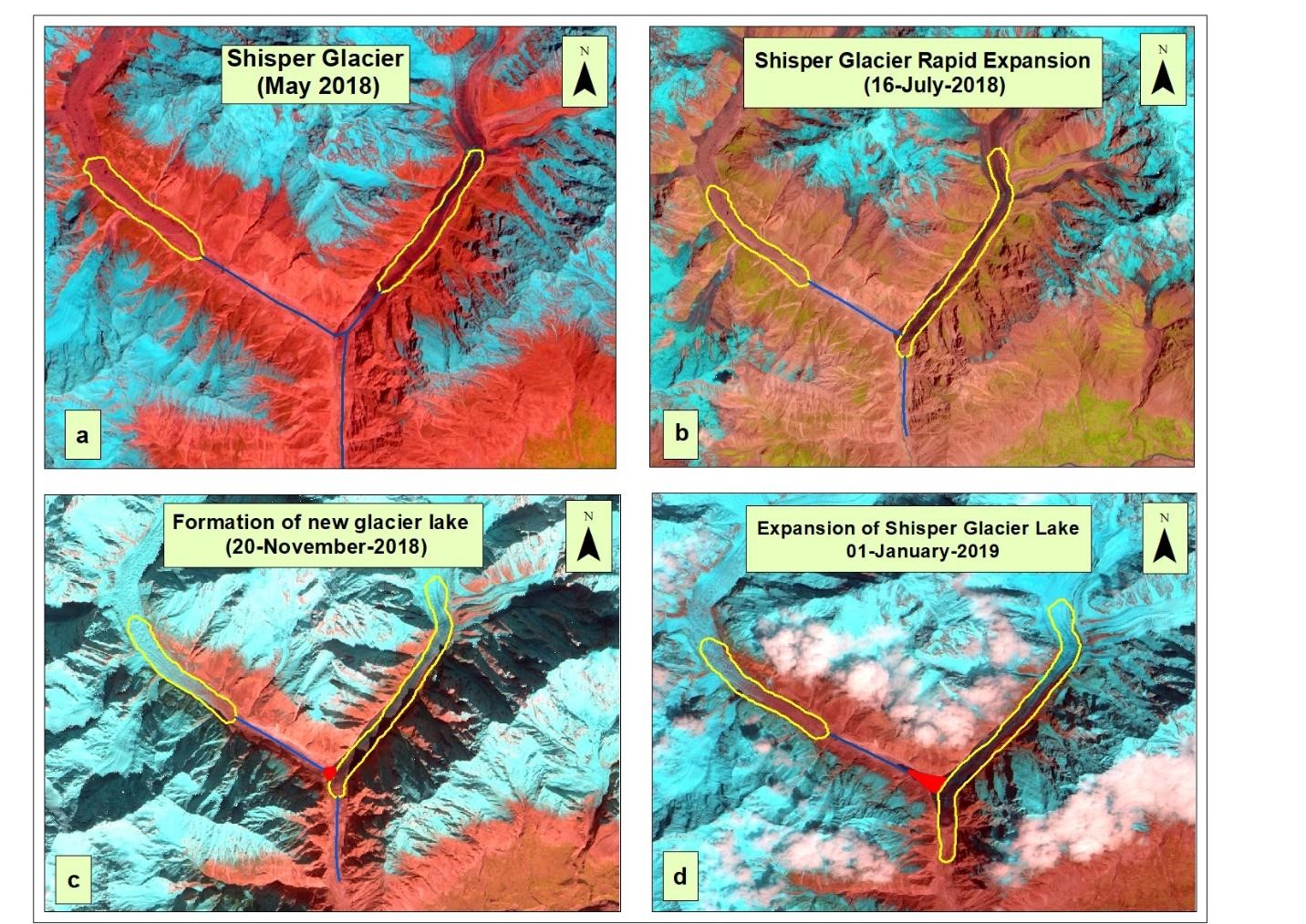A Geospatial Analysis of Shishper Glacier Surge-Upper Hunza Gilgit Baltistan
Abstract
Glaciers can be an important indicator of climate change. In Pakistan, glaciers are found in the Northern Part of the country. In this study, we have discussed the occurrence of surge velocity, lake formation, and outburst of Shisper Glacier, Hunza, Gilgit, and Baltistan. To conduct this study satellite remote sensing techniques have been used. For this purpose, Sentinel-2 and Landsat 8 have been downloaded for 2015-2019. While to examine the elevation difference ASTER 2000 and SRTM 2014 Digital Elevation Model (DEM) have been downloaded, along with this other remote sensing analyses were applied including temporal change, land cover, and morphometric analysis including indices Normalized Difference Snow Index (NDSI) and Normalized Difference Water Index (NDWI). It has been analyzed that Ice-Dammed Lake formed in November 2018, which is the greatest threat to the study area as it can cause glacial lake outbursts and the volume of the lake is showing a continuous increase from 2018- to 2020. The land cover change indicated that snow area has increased about 35% from 2015 to 2018 along with an increase in debris glacier by about 20%. Whereas, a decrease in vegetation was observed up to 2% in 3 years. This study concludes that snow and clear glacier are enlarged over time. Taking into account our research, our suggestion is obligatory stride should be taken to keep away from the disastrous occurrence in the Shisper glacier.
References
Stocker, T. F., Qin, D., Plattner, G.-K., Tignor, M., Allen, S. K., Boschung, J., Nauels, A., Xia, Y., Bex, V., & Midgley, P. M. (2013) “ Climate Change 2013: The Physical Science Basis — IPCC.” https://www.ipcc.ch/report/ar5/wg1/.
P. W. Leclercq, J. Oerlemans, and J. G. Cogley, “Estimating the Glacier Contribution to Sea-Level Rise for the Period 1800-2005,” Surv. Geophys., vol. 32, no. 4–5, pp. 519–535, Sep. 2011, doi: 10.1007/S10712-011-9121-7/FIGURES/7.
H. Jiskoot, T. Murray, and P. Boyle, “Controls on the distribution of surge-type glaciers in Svalbard,” J. Glaciol., vol. 46, no. 154, pp. 412–422, 2000, doi: 10.3189/172756500781833115.
R. Bhambri, K. Hewitt, P. Kawishwar, and B. Pratap, “Surge-type and surge-modified glaciers in the Karakoram,” Sci. Reports 2017 71, vol. 7, no. 1, pp. 1–14, Nov. 2017, doi: 10.1038/s41598-017-15473-8.
T. Yasuda and M. Furuya, “Dynamics of surge-type glaciers in West Kunlun Shan, Northwestern Tibet,” J. Geophys. Res. Earth Surf., vol. 120, no. 11, pp. 2393–2405, Nov. 2015, doi: 10.1002/2015JF003511.
H. Jiskoot, “Glacier Surging,” Encycl. Earth Sci. Ser., vol. Part 3, pp. 415–428, 2011, doi: 10.1007/978-90-481-2642-2_559.
V. Schytt, “A. [S.] Post and E. R. LaChapelle. Glacier ice. Seattle, The Mountaineers; Seattle and London, University of Washington Press, [c 1971]. [xiv], 110 p., illus. $20, £9.50.,” J. Glaciol., vol. 12, no. 65, pp. 324–325, 1973, doi: 10.3189/S0022143000032147.
J. A. Dowdeswell and T. J. Benham, “A surge of Perseibreen, Svalbard, examined using aerial photography and ASTER high resolution satellite imagery,” Polar Res., vol. 22, no. 2, pp. 373–383, Jan. 2003, doi: 10.3402/POLAR.V22I2.6466.
H. Björnsson, “Hydrological characteristics of the drainage system beneath a surging glacier,” Nat. 1998 3956704, vol. 395, no. 6704, pp. 771–774, Oct. 1998, doi: 10.1038/27384.
C. Rolstad, ] Ostein Amlien, ]on-Ove Hagen, and B. Lunden’, “Visible and near-infrared digital images for determination of ice velocities and surface elevation during a surge on Osbornebreen, a tidewater glacier in Svalbard,” Ann. Glaciol., vol. 24, pp. 255–261, 1997, doi: 10.3189/S026030550001226X.
D. Mansell, A. Luckman, and T. Murray, “Dynamics of tidewater surge-type glaciers in northwest Svalbard,” J. Glaciol., vol. 58, no. 207, pp. 110–118, Feb. 2012, doi: 10.3189/2012JOG11J058.
A. Shah, K. Ali, S. M. Nizami, I. U. Jan, I. Hussain, and F. Begum, “Risk assessment of shishper glacier, hassanabad hunza, north pakistan,” J. Himal. Earth Sci., vol. 52, no. 1, pp. 1–11, 2019.
L. Copland, M. J. Sharp, and J. A. Dowdeswell, “The distribution and flow characteristics of surge-type glaciers in the Canadian High Arctic,” Ann. Glaciol., vol. 36, pp. 73–81, 2003, doi: 10.3189/172756403781816301.
M. J. Roberts, “JÖkulhlaups: A reassessment of floodwater flow through glaciers,” Rev. Geophys., vol. 43, no. 1, pp. 1–21, Mar. 2005, doi: 10.1029/2003RG000147.
X. Wang, S. Liu, W. Guo, X. Yao, Z. Jiang, and Y. Han, “Using Remote Sensing Data to Quantify Changes in Glacial Lakes in the Chinese Himalaya,” https://doi.org/10.1659/MRD-JOURNAL-D-11-00044.1, vol. 32, no. 2, pp. 203–212, May 2012, doi: 10.1659/MRD-JOURNAL-D-11-00044.1.
L. K. Patel, P. Sharma, C. M. Laluraj, M. Thamban, A. Singh, and R. Ravindra, “A geospatial analysis of Samudra Tapu and Gepang Gath glacial lakes in the Chandra Basin, Western Himalaya,” Nat. Hazards, vol. 86, no. 3, pp. 1275–1290, 2017, doi: 10.1007/s11069-017-2743-4.
I. Rashid, U. Majeed, A. Jan, and N. F. Glasser, “The January 2018 to September 2019 surge of Shisper Glacier, Pakistan, detected from remote sensing observations,” Geomorphology, vol. 351, no. January 2018, p. 106957, 2020, doi: 10.1016/j.geomorph.2019.106957.
W. Haeberli, “Frequency and Characteristics of Glacier Floods in the Swiss Alps,” Ann. Glaciol., vol. 4, pp. 85–90, 1983, doi: 10.3189/S0260305500005280.
C. Huggel, A. Kääb, W. Haeberli, P. Teysseire, and F. Paul, “Remote sensing based assessment of hazards from glacier lake outbursts: A case study in the Swiss Alps,” Can. Geotech. J., vol. 39, no. 2, pp. 316–330, 2002, doi: 10.1139/t01-099.
S. Ali, M. J.M. Cheema, M.M. Waqas, M. Waseem, U.K. Awan, and T, Khaliq. Changes in Snow Cover Dynamics over the Indus Basin: Evidences from 2008 to 2018 MODIS NDSI Trend Analysis. Remote Sensing. (12) 2782, 2020, https://doi.org/10.3390/rs12172782.
G. Riggs, D, Hall, and M.O. Roman, VIIRS Snow Cover Algorithm Theoritical Basis document (ATBD), 2015, NASA Goddard Space Flight Center, Greenbelt, Maryland.
D. Yan, C. Huang, N, Ma, and Y. Zhang, Improved Landsat based Water and Snow Indices For extracting Lake and Snow Cover/Glacier in the Tibetan Plateau. Water. 12. 1339, 2020, https://doi.org/10.3390/w12051339.
K.. Paffen, W. Pillewizer, and H . J. Schneider. Forschungen im Hunza-Karakorum: Vorläufiger Bericht über die wissenschaftlichen Arbeiten der Deutsch-Österreichischen Himalaya-Karakorum-Expedition 1954. Erdkunde,1956, https://doi.org/10.3112/erdkunde.1956.01.01
R. Bhambri, C. S. Watson, K. Hewitt, U. K. Haritashya, J. S. Kargel, A. Pratap Shahi, P. Chand, A. Kumar, A. Verma, and H. Govil, The hazardous 2017–2019 surge and river damming by Shispare Glacier, Karakoram. Scientific Reports, 2020, https://doi.org/10.1038/s41598-020-61277-8
T. Murray, T. Strozzi, A. Luckman, H. Jiskoot, and P. Christakos, Is there a single surge mechanism? Contrasts in dynamics between glacier surges in Svalbard and other regions. Journal of Geophysical Research: Solid Earth, 2003, https://doi.org/10.1029/2002jb001906
V. Round, S. Leinss, M. Huss, C. Haemmig, and I. Hajnsek, Surge dynamics and lake outbursts of Kyagar Glacier, Karakoram. The Cryosphere Discussions, 2016, https://doi.org/10.5194/tc-2016-236
J. F. Steiner, P. D. A. Kraaijenbrink, S. G. Jiduc, and W. W. Immerzeel, Brief communication: The Khurdopin glacier surge revisited - Extreme flow velocities and formation of a dammed lake in 2017. In Cryosphere, 2018, https://doi.org/10.5194/tc-12-95-2018
Z. Zhan, Seismic Noise Interferometry Reveals Transverse Drainage Configuration Beneath the Surging Bering Glacier. Geophysical Research Letters, 2019, https://doi.org/10.1029/2019GL082411
D. Mair, Influence of subglacial drainage system evolution on glacier surface motion: Haut Glacier d’Arolla, Switzerland. Journal of Geophysical Research,2002, https://doi.org/10.1029/2001jb000514

Published
How to Cite
Issue
Section
License
Copyright (c) 2022 50SEA

This work is licensed under a Creative Commons Attribution 4.0 International License.




















